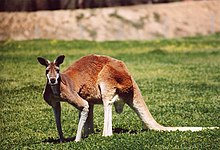The role of kangaroos’ unusually large, muscular tails appears to have been definitely answered, with scientists discovering the tail propels kangaroos forward with as much force as its front and hind legs combined.
Researchers measured the force the tail exerts on the ground and found it is critical in getting kangaroos moving at slow speeds, to a greater degree than even its legs.
Filmed experiments confirmed that kangaroos plant their tails on the ground in sequence prior to their hind legs, pushing them forwards. This gives the tail the role of a “third leg”, doing a similar job to a human leg – a far different role than proposed by the previous theory that it merely provided support and balance to kangaroos.
The research, conducted by scientists in Australia, the US and Canada, is the “final piece in the puzzle” in our understanding of kangaroos’ unusual locomotion, according to Terry Dawson, a University of New South Wales academic who has studied the animals for nearly 40 years.
“We weren’t quite sure why kangaroos diverged so much from the normal patterns of movement found in other animals,” Dawson, who worked on the study, told Guardian Australia.
“Previous studies thought the tail was just a strut, but it’s actually the front legs which are struts, they don’t provide much force. It’s the back legs and tail which provide the propulsion, much more than we previously thought.
“We didn’t know the kangaroos were using the tail as a third leg. Without that, the tail wouldn’t need to be so strong, although it would need to be pretty heavy because it is a large animal moving at speed. The males also use it for fighting, sometimes balancing on it completely in order to kick another kangaroo.”
Dawson’s study suggests the kangaroo evolved this system to free its front legs for slow-moving grazing.
A kangaroo’s movement is unusual because the animal expends a proportionally larger amount of energy when moving at slower speeds, compared with when it is going full tilt.
The marsupials can reach speeds of up to 65km per hour, with the tail performing a different role when the animal is moving quickly. The tail will be raised high to balance the kangaroo, preventing it from pitching forward.
Unlike four-legged animals such as horses and dogs, kangaroos don’t require a greater number of steps to move more quickly, the animals’ distinctive long hopping far more energy efficient than a quadruped’s rapid movement.
“Their hop is like an extreme gallop of a horse, in its aerial phase,” Dawson said. “We worked out that their legs are structured so they can take longer steps. When they go faster they straighten their legs out, making them take a much larger stride.
“The hopping locomotion got locked in a very long time ago, when a small group of possum-like animals came down from the trees and started bounding around on the ground.
“I think, after all this time, I know how they move now.”

No comments:
Post a Comment